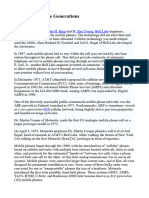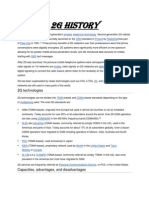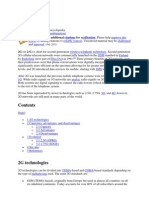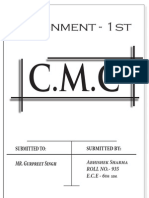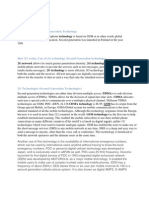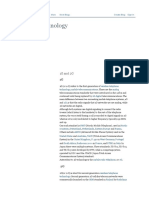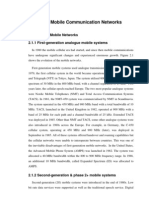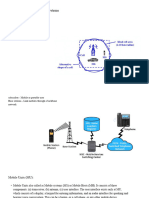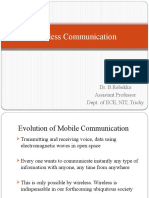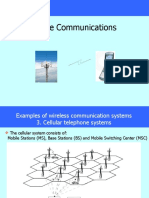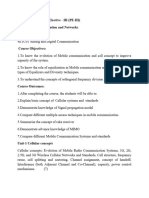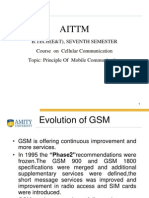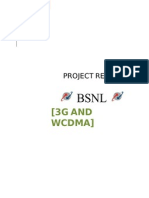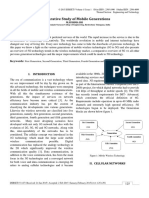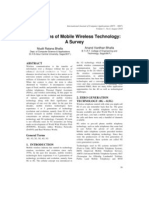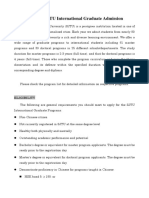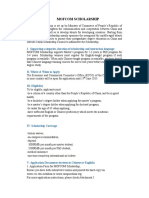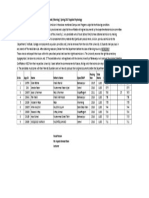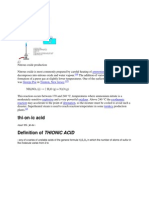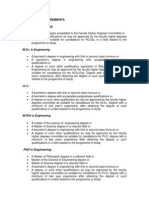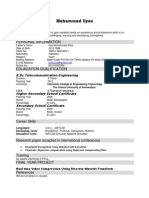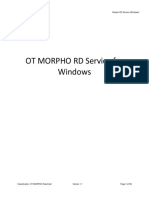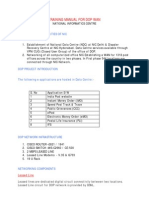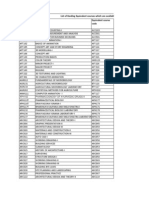7/23/2010
Global System for Mobile
Communication
A wireless mobile telecommunication Standard
` In 1876 telephone was introduced to the public
in Philadelphia USA, ALEXANDER GRAHAM BELL
was
as able to transmit speech electricall
electrically in one
direction only on COPPER WIRE. This was later
perfected for two way communication.
` In the end of 19th century a German Scientist
named HEINRICH RUDOLPH HERTZ discovered
that from an electric spark there seems to
emanate invisible waves of force which could be
captured at a distant location by a suitable
constructed receiving device.
1
� 7/23/2010
` In 1997 GUGLIELMO MARCONI made first
wireless transmission over 15KM in Bristol
andd iin 1901 h
he transmitted
i d these
h waves
overseas and began to call it RADIO.
` In 1982 first commercial ANALOG CELLULAR
SYSTEM was turned on in Chicago
` In 1992, GSM the first fully DIGITAL
CELLULAR SYSTEM was introduced on in
Germany and France
2
� 7/23/2010
` The first generation cellular systems using analog voice
transmission came into operation in 1983 and were referred to
as an analog technology
` 1G cellular systems use FM Modulation.
` Example : AMPS (Advanced Mobile Phone Services)
` 1G wireless systems provide analog speech and inefficient, low-
rate data transmission between the base station and the mobile
user.
` 1G cellular radio network includes
◦ Mobile terminals
◦ The Base Stations
◦ MSC
` Week security systems- results in hacking of
telephone
p lines.
` Poor voice quality Poor battery life Large
phone size No security, frequent call drops
Limited capacity and poor handoff reliability
between cells
3
� 7/23/2010
` Low power signal requires less battery.
` Digital voice encoding allows digital error
checking
h ki which
hi h could
ld increase
i sound d quality
li b by
reducing the noise.
` Going all digital resulted in the introduction of
digital data services such as SMS.
` Using digital signals between headset and mobile
increases the capacity of the system
` Allows more calls to be packed in the same
amount of radio bandwidth
` Digital voice data can be compressed and
multiplexed more effectively than analog voice.
` Example of 2nd Generation wireless systems include : GSM
` GSM stands for Global System for Mobile Communication
` Employ digital modulation and advanced call processing
capabilities, also have data services(GPRS, EDGE, SMS) for
mobile.
` Use Digital Systems.
` 2nd generation wireless networks have introduced new
network architectures and have reduced the computational
burden of MSC.
4
� 7/23/2010
` GSM introduced the concept of BSC ( Base Station
controller), which is inserted between several
base stations and the MSC
MSC.
` In second generation wireless networks, the
handoff is mobile-controlled and is known as
MAHO (Mobile assisted Handoff).
` Mobile networks in these networks performs
several other functions not performed by 1G
subscriber units, such as received power
reporting, adjacent base station scanning, data
encoding and encryption.
` 2nd Generation telephone standard (DECT)
allows each pphone to communicate with any y
of a number of base stations, by
automatically selecting the base station with
the greatest signal level.
` 2nd Generation wireless networks have been
specifically
ifi ll ddesigned
i d to provide
id ddata services
i
such as high data rate network access.
5
� 7/23/2010
` GPRS (General Packet Radio Service)
` GPRS enables the 2G phones to send and
receive data more rapidly
` GPRS is the end-to-end packet switching
technology provided on the basis of GSM
Technology.
` It provides data rates of 56-114 kbit/second
` GPRS is referred to 2.5 G wireless technology
` 2.5 G is a technology between the second
(2G) and third (3G) generations of mobile
telephony
` EDGE ( Enhanced Data Rates for Global
Evolution)
` Data Rate -384Kbps
` Enables three times as many bits as GPRS,
during the same period of time.
` Shorter Range (more sensitive to
noise/interference)
6
� 7/23/2010
` Third Generation wireless networks designed to
increase voice capacity and provide high-speed
data over 2G and 2.5G networks.
` A 3G network must provide a minimum of
144kbps.
` CDMA (Code Division Multiple Access) provides
the basis for 3G technology
` Implemented as CDMA2000 and WCDMA (UMTS)
` CDMA assigns unique codes to each
communication to differentiate it from others in
the same spectrum





